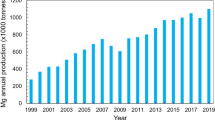Conclusions
-
1.
Deformation of pseudo-α-alloy under a temperature and rate regime that provides the occurrence of the process of dynamic recrystallization of the β-phase independently of the deformation scheme, promotes the formation of a multi-component texture with disperse and uniform arrangement of the texture components having the same crystallographic orientation. The structure of the alloy consists of recrystallized β-grains with a lamellar transcrystalline structure and individual round uniformly distributed α-grains. Such a state of structure and texture provides isotropic properties in the plane of the sheet and a high resistance to LCF in a corrosive medium.
-
2.
Deformation under temperature-and-rate regimes that do not provide processes of dynamic recrystallization of the β-phase leads either to the formation of a predominantly prismatic structure or a texture with deviated basal plane with a band pattern of texture components with the same crystallographic orientation and a band structure independently of the deformation scheme. In the presence of a prismatic texture, the mechanical properties are substantially anisotropic and the resistance to LCF in a corrosive medium diminishes in the transverse direction.
-
3.
The test method employing a plastometer used in the present work allowed us to determine the temperature and deformation range of the formation of specific structure and texture states in pseudo-α-alloy with a sufficiently high reliability.
Similar content being viewed by others
References
N. F. Anoshkin, M. Ya. Brun and G. V. Shakhanova, “Requirements on a bimodal structure with optimum set of mechanical properties and regimes of its preparation,”Titan, No. 1(10), 35–40 (1998).
M. Ya. Brun and G. V. Shakhanova, “On the structure of titanium alloys and parameters determining its variety,”Titan, No. 1, 24–29 (1993).
O. A. Gubina, V. N. Kopylov, I. N. Razuvaeva, and A. S. Shibanov, “Anisotropy of mechanical properties of titanium semi-products produced by the method of die forging,”Metalloved. Term. Obrab. Met., No. 12, 14–16 (1993).
S. Ushkov, V. Krivitskiy, I. Razuvaeva, and V. Kopylov, “The regularities of structure formation in pseudo-α-Ti alloy under hot deformation, Titanium-92,”Sci. Technol.,1, 683–688 (1992).
M. L. Bernshtein,Diagrams of Hot Deformation, Structure, and Properties of Steels [in Russian], Metallurgiya, Moscow (1989).
I. G. Malcor and F. Montheillet, “Loi de compartement de l’alliage de titane, Ti-6% Al-4% V dans le domaine du forgeage a’chaud,”Memories et Etudes Scientifiques Revue de Metallurgie,80, 89–103 (1983).
R. W. K. Honeycombe and R. W. Pethen, “Dynamic recrystallization,”J. Less-Common Metals,28(2), 201–208 (1972).
L. N. Larikov, “Dynamic return and dynamic recrystallization,”Metally, No. 2, 69–75 (1982).
S. S. Gorelic,Recrystallization of Metals and Alloys [in Russian], Metallurgiya, Moscow (1978).
V. V. Rybin,High Plastic Deformations and Fracture of Metals [in Russian], Metallurgiya, Moscow (1986).
G. V. Sakjanova, et al., “Resistance of deformation and dynamic change in the structure of two-phase Ti-alloys under hot deformation,” in:Titanium-80, 4th Int. Conf. on Titanium, Kyoto, Japan, 1980, pp. 849–861.
I. N. Razuvaeva, A. A. Babareko, V. N. Kopylov, G. V. Medvedeva, and N. M. Dobrodeeva, “Formation of structure and texture of titanium pseudo-α-alloy rolled in the (α+β) region,”Fiz. Met. Metalloved., No. 11, 99–107 (1991).
N. V. Ageev (ed.),The Theory of Texture Formation in Metals and Alloys [in Russian], Nauka, Moscow (1975).
A. A. Babareko and O. S. Belova, “A study of phase transformations in titanium alloys under deformation,”Fiz. Met. Metalloved.,62, Issue 5, 944 (1986).
A. A. Babareko, I. V. Égiz, O. S. Belova, and N. M. Dobrodeeva, “Special features of formation of basal texture in sheets of pseudo-α-alloy of the Ti−Al−V system under different rolling conditions,”Fiz. Met. Metalloved.,65, Issue 5, 940 (1988).
M. I. Blackborn, I. A. Frechney, and T. R. Beck, “Stress-corrosion cracking of titanium alloys,”Adv. Cor. Sci. Technol.,3(1), 67–292 (1973).
Additional information
Translated from Metallovedenie i Termicheskaya Obrabotka Metallov, No. 9, pp. 38–44, September, 1999.
Rights and permissions
About this article
Cite this article
Ushkov, S.S., Kopylov, V.N. & Razuvaeva, I.N. Scientific aspects of the choice of the regulated structural state and texture of “marine” titanium alloys. Met Sci Heat Treat 41, 402–407 (1999). https://doi.org/10.1007/BF02469879
Issue Date:
DOI: https://doi.org/10.1007/BF02469879




